

Mereological essentialism. Mereological essentialism is a philosophical thesis about the relationship between wholes and its parts, and the conditions for their persistence.
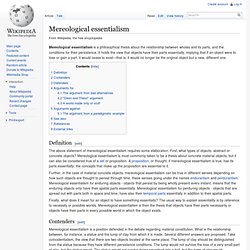
It holds the view that objects have their parts essentially, implying that if an object were to lose or gain a part, it would cease to exist—that is, it would no longer be the original object but a new, different one. Definition[edit] Further, in the case of material concrete objects, mereological essentialism can be true in different senses depending on how such objects are thought to persist through time, these senses going under the names endurantism and perdurantism. Mereological essentialism for enduring objects - objects that persist by being wholly present every instant, means that the enduring objects only have their spatial parts essentially. Mereological essentialism for perduring objects - objects that are spread out with parts both in space and time, have also their temporal parts essentially in addition to their spatial parts.
Haecceity. Haecceity (/hɛkˈsiːɪtɪ/; from the Latin haecceitas, which translates as "thisness") is a term from medieval philosophy first coined by Duns Scotus which denotes the discrete qualities, properties or characteristics of a thing which make it a particular thing.

Haecceity is a person or object's "thisness", the individualising difference between the concept 'a man' and the concept 'Socrates' (a specific person).[1] Charles Sanders Peirce later used the term as a non-descriptive reference to an individual.[2] Haecceity and quiddity[edit] Haecceity may be defined in some dictionaries as simply the "essence" of a thing, or as a simple synonym for quiddity or hypokeimenon.
However, such a definition deprives the term of its subtle distinctiveness and utility. Ship of Theseus. The paradox had been discussed by more ancient philosophers such as Heraclitus, Socrates, and Plato prior to Plutarch's writings; and more recently by Thomas Hobbes and John Locke.
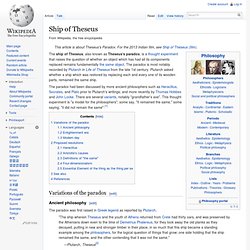
There are several variants, notably "grandfather's axe". This thought experiment is "a model for the philosophers"; some say, "it remained the same," some saying, "it did not remain the same".[1] Variations of the paradox[edit] Ancient philosophy[edit] The paradox was first raised in Greek legend as reported by Plutarch, "The ship wherein Theseus and the youth of Athens returned from Crete had thirty oars, and was preserved by the Athenians down even to the time of Demetrius Phalereus, for they took away the old planks as they decayed, putting in new and stronger timber in their place, in so much that this ship became a standing example among the philosophers, for the logical question of things that grow; one side holding that the ship remained the same, and the other contending that it was not the same. " Nihilism.
Nihilism is also a characteristic that has been ascribed to time periods: for example, Jean Baudrillard and others have called postmodernity a nihilistic epoch,[4] and some Christian theologians and figures of religious authority have asserted that postmodernity[5] and many aspects of modernity[3] represent a rejection of theism, and that such rejection of their theistic doctrine entails nihilism.
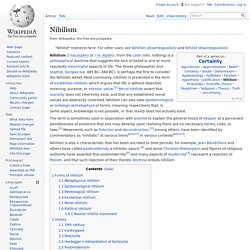
Forms of nihilism[edit] Nihilism has many definitions, and thus can describe philosophical positions that are arguably independent. Purpose. Intentional behavior can also be just thoughtful and deliberate goal-directedness.

Recent research in experimental philosophy has shown that other factors may also matter for whether or not an action is counted as intentional. Philosophy[edit] G.E.M. Anscombe made the topic of intentional action a major topic of analytic philosophy with her 1957 work Intention. She argued that intentional action was coextensive with action of which one could ask "why were you doing that? " Śūnyatā. Śūnyatā, (Sanskrit, also shunyata; Pali: suññatā), in Buddhism, translated into English as emptiness, voidness,[1] openness,[2] spaciousness, vacuity, is a Buddhist concept which has multiple meanings depending on its doctrinal context.
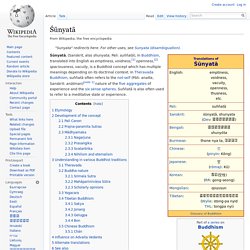
In Theravada Buddhism, suññatā often refers to the not-self (Pāli: anatta, Sanskrit: anātman)[note 1] nature of the five aggregates of experience and the six sense spheres. Suññatā is also often used to refer to a meditative state or experience. Three men make a tiger. "Three men make a tiger" (Chinese: 三人成虎; pinyin: sān rén chéng hǔ) is a Chinese proverb or chengyu (four-character idiom).
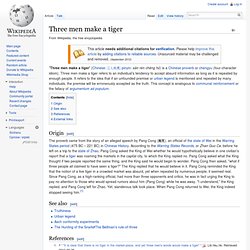
Three men make a tiger refers to an individual's tendency to accept absurd information as long as it is repeated by enough people. It refers to the idea that if an unfounded premise or urban legend is mentioned and repeated by many individuals, the premise will be erroneously accepted as the truth. This concept is analogous to communal reinforcement or the fallacy of argumentum ad populum. Sorites paradox. The change in size between consecutive "big" heaps (left) is twice that of the change between consecutive "little" heaps (right), yet seems less significant.

The original formulation and variations[edit] Paradox of the heap[edit] The word "sorites" derives from the Greek word for heap.[5] The paradox is so named because of its original characterization, attributed to Eubulides of Miletus.[6] The paradox goes as follows: consider a heap of sand from which grains are individually removed. One might construct the argument, using premises, as follows:[4]